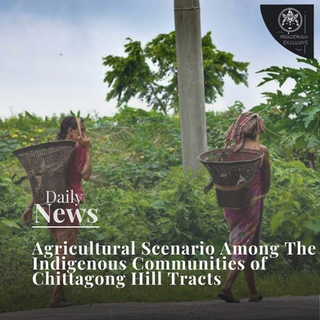Agricultural scenario among the indigenous communities of Chittagong Hill Tracts
- Indigenous Exclusive
- Sep 9, 2021
- 3 min read
An area of 13,295 sq km in the southeastern part of Bangladesh, known as the Chittagong Hill Tracts (CHT), is home to 11 indigenous communities namely Marma, Chakma, Murong, Tripura, Lusai, Khumi, Bom, Kheyang, Chak, Pankho and Tangchangya. They have been living in their own socio-economic condition for ages.
Their socio-economic status depends largely on indigenous agriculture which is quite aloof from mainstream agricultural method.
There are seen two forms of agriculture in the CHT, one is Jum Cultivation (shifting cultivation) and the other is Farming.
The CHT is mostly a hilly area because of which from the very first Jum cultivation tended to be seen in this area at least before the indigenous communities were introduced to the farming system.
Jum cultivation, also known as swidden or shifting cultivation, is a local name for slash and burn agriculture practiced by the indigenous communities in the CHT.
This refers to cutting and burning down the trees of a hill in order to sowing, tending and harvesting crops. In Jum cultivation, seeds are usually sown after the first rain between May and June. Through this cultivation a variety of food products are yielded such as paddy, cucumber, pumpkin, sesame, banana, various vegetables, maize, ginger, chillies, eggplant, okra, lemon etc which contribute significantly to the economic condition of the indigenous communities. They make a living by selling the products in the markets produced in Jum Cultivation.
Indigenous peoples in non-industrial society mostly depended on this Jum cultivation for their livelihood. At present it seems that they aren’t limited to Jum Cultivation anymore. One of the reasons is the agro-ecological setting of the village and another is the farmers’ socio-economic capability on their farming.
In post industrial society it is seen that many are inclined towards agro-ecological cultivation.
This is because it is seen they are noticing that they get more production from agricultural cultivation in terms of crop yields than obtained from jum cultivation.
Agriculture is the art and science of cultivating the soil, growing crops and raising livestock. It includes the preparation of plant and animal products for people to use and their distribution to markets. Agriculture provides most of the world's food and fabrics.
For agriculture, Irrigation and terracing are must needed. Irrigation is what makes possible a land to use year after year. It makes contingent the farmers to control the water in terms of utilizing for the cultivation. Terracing is a soil conservation practice that helps protect the land from rainwater and deadly erosion.
There is another reason why indigenous peoples tend to agricultural cultivation. Due to the British colonial policy, jum cultivation and jum farmers were gradually marginalized in the CHT, a process that was accelerated after the end of British rule.
On the other hand, due to various administrative measures taken by the British, a growing section of the population like Chakmas, Marmas and Tripuras started leaning towards permanent cultivation in the plain lands that is Farming.
Rice, vegetables, potatoes, mustard, oats, watermelon, coriander and chilli etc are now cultivated in most of the plain lands of the CHT.
Despite the use of high quality machinery in the agricultural system of Bangladesh nowadays, indigenous farmers have not yet been able to meet the imprints of modernity due to poor economic state.
Therefore many indigenous farmers are still lagging behind than other farmers in Bangladesh as they have poor idea about the importance of agricultural education.In this case, the government should take important steps to educate them and provide technical education on the use of modern machinery.
However, agriculture seems to strengthen the foundation of the domestic economy of many indigenous families of CHT through food security, self-reliance in food grain production, industrialization, poverty alleviation, etc.
Written by Saptorshi Dewan








Comments